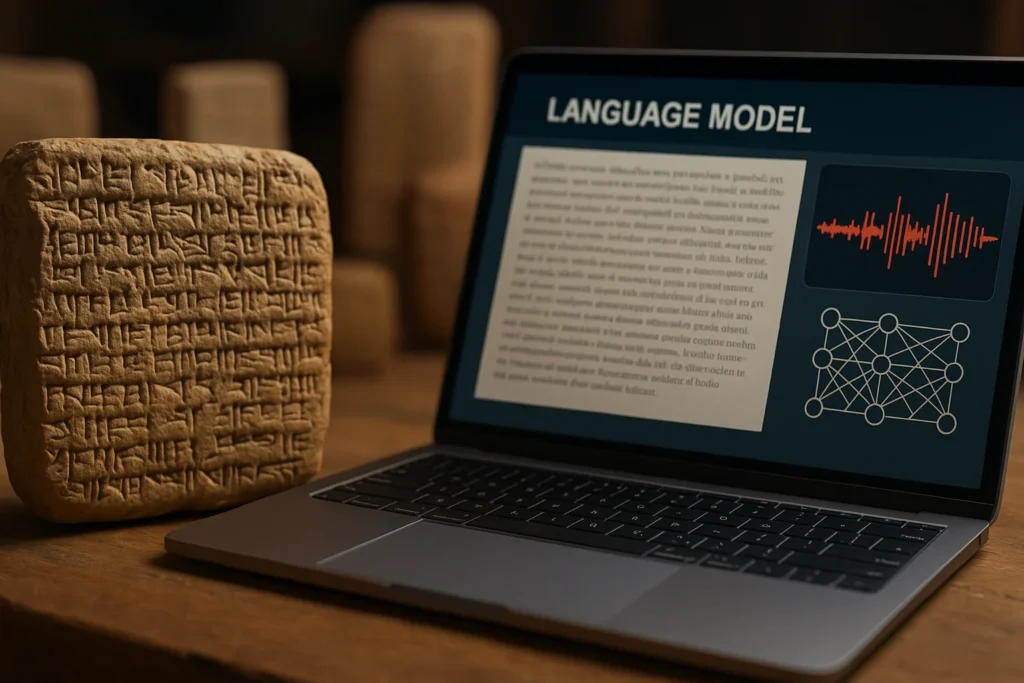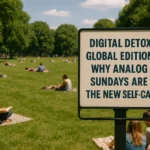The Whisper in the Clay Tablet
Dr. Elias Kostas carefully adjusted the high-resolution scanner over the ancient Minoan tablet in his Athens laboratory. The fired clay bore mysterious symbols – Linear A script, untouched for 3,500 years since some unknown scribe pressed reed to wet clay in the palace of Knossos. As the scanner hummed, its images fed directly into the “Phoenix” language reconstruction AI developed at the University of California, Berkeley.
“Most people see dead languages as academic puzzles,” Elias murmured to his assistant. “But these markings represent someone’s grocery list, or love poem, or prayer for their sick child. That humanity deserves to be heard again.”
The AI began its work, comparing the symbols against its vast database of known languages, archaeological context, and grammatical patterns. Within minutes, tentative translations appeared on screen:
[Symbol cluster 12A] → possibly “grain” or “barley”
[Repeating symbol] → likely numerical count
[Final markings] → potential religious invocation
Elias’s hands trembled. This particular tablet might finally reveal what the Minoans called their primary grain crop – a simple word that could unlock understanding of their entire agricultural economy.
The Race Against Time
Across the world’s linguistics departments and tech labs, researchers are engaged in what Dr. Fatima al-Rashid calls “the most ambitious cultural rescue mission in human history.” The numbers tell a sobering story:
- Of approximately 7,000 languages spoken today, nearly half are endangered
- Every two weeks, the last native speaker of a language dies
- Ancient languages known only from inscriptions may number in the thousands
- Climate change is accelerating the decay of vulnerable artifacts
“Language extinction isn’t just about words disappearing,” explains Dr. al-Rashid of the Endangered Languages Archive. “It’s entire ways of seeing the world, medicinal knowledge, oral histories – whole cultures evaporating before we even knew to listen for them.”
The AI Rosetta Stones
Modern language reconstruction employs several groundbreaking techniques:
1. Neural Network Pattern Recognition
The “Babel” system at MIT can:
- Analyze character shapes across hundreds of inscriptions
- Detect subtle variations that indicate grammatical rules
- Reconstruct probable pronunciations using phonetic algorithms
When applied to Etruscan texts, Babel identified previously unknown verb conjugations that confirmed the language’s non-Indo-European roots.
2. Contextual Archaeology Matching
The “Artemis” platform at Oxford cross-references:
- Inscriptions with their physical locations (temples vs. taverns)
- Associated artifacts (weapons, tools, pottery)
- Climate data from the period
This helped decode Mayan glyphs about drought cycles by linking them to geological records.
3. Comparative Linguistics AI
Systems like “GlottoTech” can:
- Map known languages onto family trees
- Predict features of their common ancestors
- Fill gaps in partial inscriptions
This reconstructed 38% of the ancient Iberian language despite having no bilingual texts.
Breakthroughs That Rewrote History
The Indus Valley Revelation
For over a century, the Harappan civilization’s script resisted decipherment. In 2024, the “Indus AI” project made a leap by:
- Analyzing 4,000+ seal inscriptions
- Matching symbol frequencies to Sumerian trade records
- Identifying “fish” glyphs that represented sounds rather than meanings
The breakthrough revealed Harappan was likely a Dravidian language, confirming South Indian cultural links dating back 4,000 years.
Resurrecting Gaulish
Once spoken from France to Turkey, Gaulish vanished by the 6th century CE. Using:
- Coin inscriptions
- Curse tablets
- Caesar’s Gallic Wars descriptions
AI reconstructed over 1,200 words, including the beautiful “ambiaktos” (dusk, literally “around-day”), giving new insight into Celtic cosmology.
The Rongorongo Enigma
Easter Island’s mysterious wooden tablets may finally be yielding secrets. A Hawaiian research team’s AI:
- Discovered lunar calendar patterns
- Identified genealogical records
- Found matches to Polynesian navigation terms
This supports oral histories about the island’s deliberate settlement rather than accidental drift.
The Human-AI Partnership
At the University of Sydney, linguists work alongside the “TerraLingua” AI in a unique collaboration:
- Elders from indigenous communities vet translations
- AI suggests possible meanings for unknown words
- Communities decide which interpretations fit cultural context
“This isn’t about machines replacing human knowledge,” explains project lead Dr. Marama Tui. “It’s about giving indigenous experts powerful new tools to reclaim their heritage.”
Ethical Minefields
Not all communities welcome these efforts. The Navajo Nation recently banned AI analysis of their language, while some Australian aboriginal groups have demanded the return of recordings from archives.
Key concerns include:
- Commercial exploitation of revived languages
- Distortion of cultural meanings
- Religious protocols around sacred words
- Data sovereignty issues
“The question isn’t just can we revive a language,” notes ethicist Dr. Rajiv Patel, “but whether we should, and who gets to decide.”
The Next Frontier
Exciting developments on the horizon:
- Voice Reconstruction – Systems like “Vox Antiqua” can simulate how ancient languages might have sounded based on:
- Skeletal remains’ vocal tract dimensions
- Poetic meter patterns
- Contemporary descriptions
- Real-Time Translation – Field archaeologists may soon use AR glasses to instantly read inscriptions during digs.
- Generative Storytelling – AI could help reconstruct lost myths and oral traditions from fragmentary evidence.
How You Can Participate
- Citizen Science Projects:
- Transcribe manuscripts at the Global Epigraphy Project
- Record elder storytellers for the Mother Tongue Initiative
- Local Action:
- Support indigenous language programs
- Advocate for museum artifact repatriation
- Digital Preservation:
- Contribute to Wikipedia in endangered languages
- Upload recordings to the Endangered Languages Archive
Voices From the Dust
Back in Athens, Dr. Kostas made a remarkable discovery. That Linear A tablet? It wasn’t an inventory as assumed. The AI’s latest analysis suggested it was a prayer:
“To the Earth-Shaker, we offer first fruits
May the stones sleep and the waves stay calm
For our children’s children”
Simple words from a long-vanished world, now speaking directly to ours across 35 centuries. That, perhaps, is the true power of this technology – not just solving academic puzzles, but rebuilding the bridges of human connection that time had broken.
As the sun set over the Aegean, Elias played the AI’s reconstructed pronunciation. The syllables, last uttered when Bronze Age ships plied these waters, once again filled the air – tentative, imperfect, but undeniably alive.




0h01b3